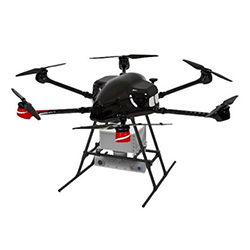Unmanned airborne hazardous gas remote sensing imaging alarm system
2022-12-31
The unmanned aerial vehicle hazardous gas remote sensing imaging alarm system (model GIRDIS-1) is the world's first passive Fourier transform infrared spectroscopy visualization gas remote sensing monitoring and early warning device installed on unmanned aerial vehicles for aerial inspection. It is completely independently developed in China and has established a new application mode for non-contact large-scale stereoscopic monitoring of hazardous gases on unmanned aerial vehicles as a platform. The system is capable of real-time monitoring of toxic, harmful, flammable, explosive, and other hazardous gases, industrial emissions within a radius of several kilometers from the carrier. It automatically performs qualitative analysis and quantitative inversion, provides real-time alerts, and can detect over 400 types of substances.
The unmanned aerial vehicle hazardous gas remote sensing imaging alarm system can hover monitoring, flight monitoring, day and night fully automatic imaging monitoring and warning, visualize the whole process, real-time scene video, multi-dimensional intuitive dynamic display results, and the gas distribution and diffusion trend are clear at a glance, which is conducive to rapid source tracing and positioning; Automatically save and send back data, and support remote distribution. The system is safe, convenient, efficient, and sensitive, suitable for different environments and occasions.
![]()
![]()
Figure 1 Hazardous gas remote sensing imaging detection pod
![]()
Figure 2 Unmanned Aerial Hazardous Chemical Gas Remote
Sensing Imaging Alarm System (Air Subsystem)
1. Product advantages
(1) The unmanned aerial vehicle (UAV) approach overcomes terrain limitations, occlusion limitations, and distance limitations, allowing for more flexible and agile construction of monitoring areas. No need for on-site sampling, solving the problem of difficult sampling and detection in chimneys, water surfaces, and other places; For areas with unknown conditions, personnel and equipment do not need to enter the site to work and do not have to bear unknown risks.
(2) Remote real-time monitoring can automatically monitor the area within a radius of several kilometers centered on the carrier.
(3) Advanced infrared spectroscopy imaging telemetry technology, capable of day and night imaging detection.
(4) Aviation grade Stirling refrigeration ensures stable and accurate detection without the need for liquid nitrogen or auxiliary materials, making it agile and efficient.
(5) Quick identification, complete analysis and recognition in seconds. The product can be recognized based on one image through independently developed advanced algorithms and hardware design.
(6) There are many types of identification, including toxic and harmful gases, and polluting gases. The identification of gas types can be customized and expanded. It can simultaneously detect and analyze different gases mixed together and provide separate results.
(7) High safety, remote non-contact work, personnel and equipment will not be harmed by hazardous gases; Passive detection does not radiate energy to the detection area, avoiding the danger of triggering flammable and explosive gases within the detection area.
(8) It can dynamically display the distribution and diffusion trend of gases, provide real-time gas orientation, and facilitate traceability and positioning.
2.Main technical indicators
(1) Detection method: Passive Fourier transform infrared spectroscopy telemetry.
(2) Monitoring videos: visible videos and infrared videos.
(3) Video resolution: Visible video resolution of 720P; Infrared video resolution 640 × 512.
(4) Spectral range: 7um to 14um.
(5) Maximum detection distance: ≮ 3km.
(6) Scanning range: horizontal, 0 ° to 360 °; Pitch- 60 ° to 0 °.
(7) Detectable gas types: ≥ 60 types, gas types can be customized and expanded;
Industrial gases: including but not limited to sulfur dioxide, nitrogen oxides, hydrogen chloride, hydrogen sulfide, etc; Aromatic hydrocarbons such as benzene, toluene, and xylene; Methane, ethane and other hydrocarbons; Alcohols such as methanol and ethanol; Ethylene, propylene, butene and other olefins;
Polluting gases: volatile organic compounds (VOCs), etc.
(8) Identification response time: ≤ 2s.
(9) Pod size: 464mm (length) x 360mm (width) x 375mm (height).
(10) Pod weight: 21kg.
(11) Result display: Real time graphic and textual display of detection results, including gas name, gas concentration, and gas distribution.
(12) Data storage: Automatically save monitoring data.
(13) Data query: Conditions can be set to query monitoring data, including monitoring time, detection method, etc; The query results include gas name, concentration, and monitoring result images.
3. Price advantage
We are well aware that price is one of the important factors that consumers consider. To ensure that you can enjoy cost-effective products, we have taken a series of measures to reduce costs. We have achieved effective cost control by optimizing production processes, negotiating more favorable procurement prices with suppliers, and adopting advanced technology to improve production efficiency. In addition, we regularly review and adjust product pricing to ensure that our pricing strategy meets market demand and provides you with a true price advantage. Choosing us means choosing quality and service that offers value for money.
Anhui Lijian Defense Technology Co., Ltd Copyright 皖ICP备20002291号-1 disclaimer

